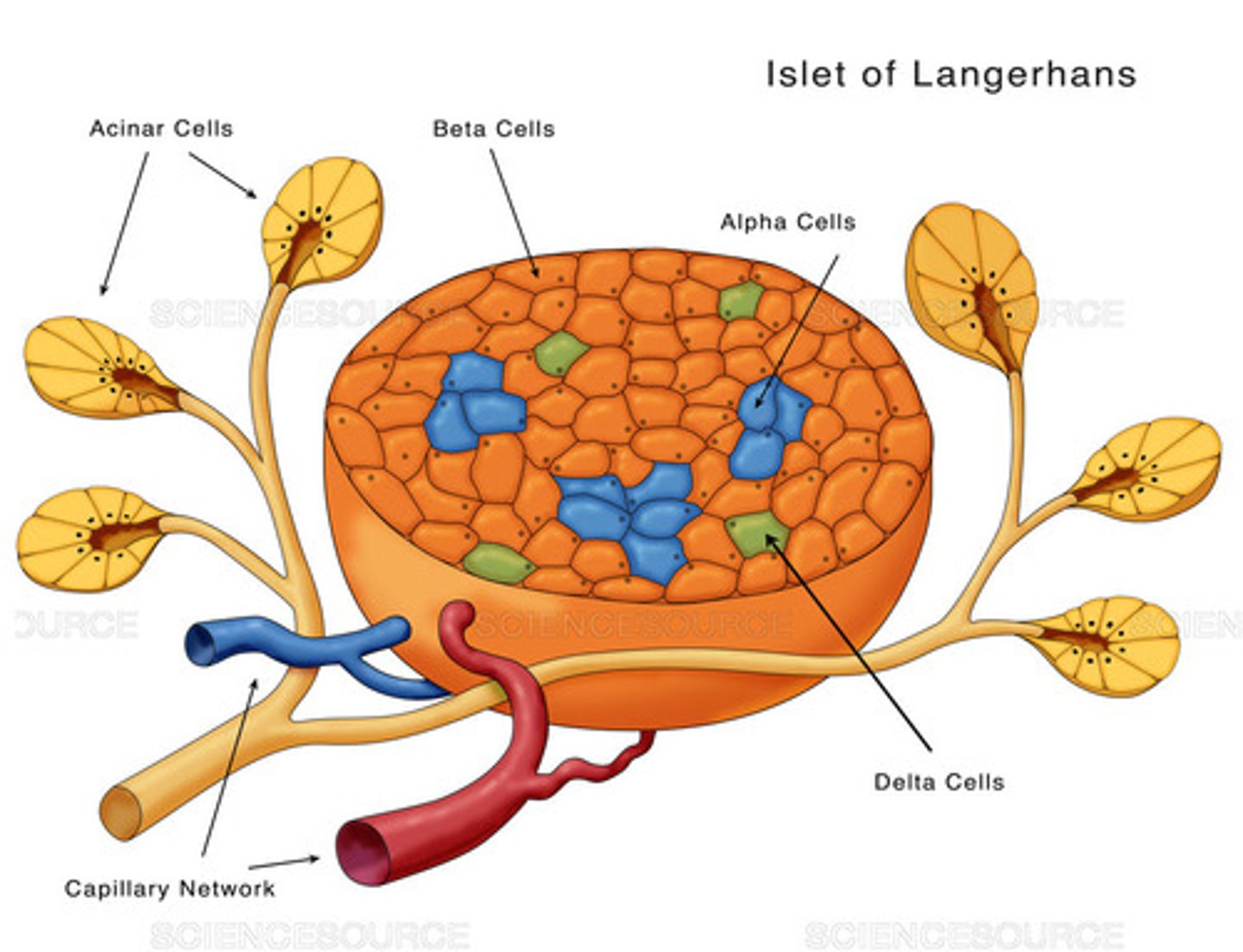Organisms response - Blood glucose
1/35
There's no tags or description
Looks like no tags are added yet.
Name | Mastery | Learn | Test | Matching | Spaced |
|---|
No study sessions yet.
36 Terms
By what system are blood glucose levels controlled?
Homeostasis
What do levels of glucose in the blood effect?
- Water potential
- Blood pressure
- Availability of respiratory substrates
What happens to the brain if blood glucose becomes too low?
Cells become damaged and rapidly die as they cannot respire
What happens to blood pressure if glucose levels become too high?
1. Water potential of blood decreases
2. Water moves in
3. This increases the volume of blood
4. This causes blood pressure to rise
How can glucose enter the bloodstream?
- Absorption from the gut following digestion
- Hydrolysis of glycogen stores
- Converting non-carbs such as lipids and proteins into glucose
Why does the amount of glucose gained from meals vary?
It is dependent on the carb content of the meal
What are the hormones that regulate blood glucose levels?
- Insulin
- Glucagon
Where is insulin and glucagon secreted?
Pancreas
What tissue in the pancreas secrete insulin and glucagon?
Islets of Langerhans

What are the two types of cells in the islets of Langerhan?
Alpha cells and beta cells
What do alpha cells produce?
Glucagon
What do beta cells produce?
Insulin
Describe the role of the alpha and beta cells?
They act as receptors and also initiate response to blood glucose levels
What cells act as the targets/effectors that respond to insulin?
Liver, muscle and fat cells
How do alpha and beta cells respond to high blood glucose?
Beta starts to secrete insulin and alpha stops secreting glucagon
Describe the secretion of insulin.
1. High blood glucose is detected by beta cells in the pancreas
2. Glucose is absorbed into the beta cells via carrier proteins
3. This causes insulin containing vesicles to move towards the cell surface
4. The vesicles release the insulin into the capillaries
5. Insulin circulates the body, stimulating the uptake of glucose by muscle, fat and liver cells
How do the effector cells uptake glucose from the blood?
1. Insulin binds to specific receptors on the membrane of the target/effector cells
2. These cells possess some glucose transported proteins in their surface membranes
3. The binding of insulin stimulates the cells to add more glucose transporter molecules to the surface membrane
4. Increased permeability to glucose so rate of facilitated diffusion increases
What does glucose stimulate in the liver?
Glycogenesis
Describe the action of glycogenesis in the liver.
1. Glucose enters the liver cell
2. It is converted to glucose phosphate by an enzyme
3. Another enzyme then converts this into glycogen
4. This lowers glucose conc in the liver so more glucose moves in from the bloodstream
How do the alpha and beta cells respond to low blood glucose?
Beta cells stop secreting insulin and alpha cells start secreting glucagon
What cells act as the targets/effectors that respond to glucagon?
Liver and muscle cells
How do effector cells respond to the production of glucagon?
They begin the second messenger model which breaks down the glucagon in the cells into glucose to return to the blood stream and raise blood sugar
What is the second messenger model?
The binding of the hormone to cell receptors activates an enzyme on the inside of the cell membrane which then produces a chemical known as a 2nd messenger
Describe the second messenger model.
1. Glucagon binds to the surface membrane of liver and muscle cells
2. This causes a change in a receptor that activates a G protein
3. This G protein activates the enzyme adenylyl cyclase
4. Active adenylyl cyclase catalyses the conversion of ATP to cyclic AMP or cAMP
5. cAMP binds to protein kinase A enzymes and activates them
6. These enzymes catalyse the breakdown of glucagon to glucose (glycogenolysis)
What is an enzyme cascade?
An enzyme chain which works like a set of dominos, if stopped anywhere in the process the cascade is compromised. The second messenger model is an example of this
What is the first and second messeger?
Glucagon and then cAMP
How does adrenaline affect blood glucose?
It increases the concentration of blood glucose
What cells act as the targets/effectors that respond to adrenaline?
Liver cells
How does adrenaline increase glucose concentration?
It binds to a specific receptor on liver cells which activate the second messenger model
What is the second messenger model for adrenaline?
1. Adrenaline binds to the surface membrane of liver cells
2. This causes a change in a receptor that activates a G protein
3. This G protein activates the enzyme adenylyl cyclase
4. Active adenylyl cyclase catalyses the conversion of ATP to cyclic AMP or cAMP
5. cAMP binds to protein kinase A enzymes and activates them
6. These enzymes catalyse the breakdown of glucagon to glucose (glycogenolysis)
What does adrenaline stimulate in muscle cells?
During exercise, it stimulates the breakdown of glycogen that is stored in them so they can be used for respiration
How does the liver help convert between glycogen and glucose?
The binding of insulin and glucagon stimulates three processes in the liver:
- Glycogenolysis
- Glycogenesis
- Gluconeogenesis
Summarise glycogenesis.
- Synthesis of glycogen from glucose
- Triggered by insulin as a result of high blood glucose
- Removes glucose from blood stream
Summarise glycogenolysis.
- Breakdown of glycogen to glucose
- Triggered by glucagon as a result of low blood glucose
- Returns glucose to blood stream
Summarise gluconeogenesis.
- Synthesis of glucose from non-carb molecules by activating enzymes in liver
- Triggered by glucagon as a result of low blood glucose
- Adds glucose to blood stream
In what order are the other non-carb molecules used in gluconeogenesis?
1. Lipids (fats)
2. Proteins